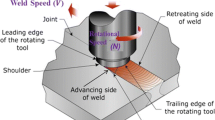Abstract
A coupled thermal/material flow model of friction stir processing is developed for friction stir processing of an as-cast AlSi9Mg aluminum alloy. By capturing material flow during processing, an asymmetric temperature distribution is generated with higher processing temperatures on the advancing side than on the retreating side. The temperature distribution from the coupled model is then incorporated into a thermomechanical model to predict the residual stress state after processing. These numerical results are compared with the residual stresses experimentally measured by the trepanation method. Experimental results show that the tensile residual stresses are higher on the advancing side than on the retreating side. The simulation successfully captures the asymmetric behavior of the residual stress profile, and the predicted maximum residual stress values show relatively good agreement with the experimental values. The simulated profile, however, is narrower than the experimental profile, yielding a smaller region of tensile residual stresses around the process zone than experimentally observed.





Similar content being viewed by others
References
M. Mahoney, C. Fuller, M. Miles, and W. Bingel, Friction Stir Welding and Processing III, TMS, Warrendale, PA, 2005, p 131–138
T.S. Mahmoud and S.S. Mohamed, Improvement of Microstructural, Mechanical and Tribological Characteristics of A413 Cast Al Alloys Using Friction Stir Processing, Metall. Mater. Trans. A., 2012, 558, p 502–509
P.L. Threadgill, A.J. Leonard, H.R. Shercliff, and P.J. Withers, Friction Stir Welding of Aluminium Alloys, Int. Mater. Rev., 2009, 54(2), p 49–93
O. Hatamleh, I.V. Rivero, and J. Lyons, Evaluation of Surface Residual Stresses in Friction Stir Welds Due to Laser and Shot Peening, J. Mater. Eng. Perform., 2007, 16(5), p 549–553
G. Bussu and P.E. Irving, The Role of Residual Stress and Heat Affected Zone Properties on Fatigue Crack Propagation in Friction Stir Welded 2024-T351 Aluminum Joints, Int. J. Fatigue, 2003, 25(1), p 77–88
D.M. Neto and P. Neto, Numerical Modeling of Friction Stir Welding Process: A Literature Review, Int. J. Adv. Manuf. Technol., 2013, 65(1–4), p 115–126
D.G. Richards, P.B. Prangnell, S.W. Williams, and P.J. Withers, Global Mechanical Tensioning for the Management of Residual Stresses in Welds, Metall. Mater. Trans. A., 2008, 489(1–2), p 351–362
D. Jacquin, B. de Meester, A. Simar, D. Deloison, F. Montheillet, and C. Desrayaud, A Simple Eulerian Thermomechanical Modeling of Friction Stir Welding, J. Mater. Process. Technol., 2011, 211(1), p 57–65
P. Heurtier, M.J. Jones, C. Desrayaud, J.H. Driver, F. Montheillet, and D. Allehaux, Mechanical and Thermal Modeling of Friction Stir Welding, J. Mater. Process. Tech., 2006, 171(3), p 348–357
Y. Javadi, S. Sadeghi, and M.A. Najafabadi, Taguchi Optimization and Ultrasonic Measurement of Residual Stresses in the Friction Stir Welding, Mater. Des., 2014, 55(3), p 27–34
M. St. Węglowski, and S. Dymek, Microstructural Modification of Cast Aluminium Alloy AlMg9Si via Friction Modified Processing, Arch. Metall. Mater., 2012, 57(1), p 71-78
M. St. Węglowski, A. Pietras, S. Dymek, and C. Hamilton, Characterization of Friction Modified Processing: A Novel Tool for Enhancing Surface Properties in Cast Aluminium Alloys. Key Eng. Mater., 2012, 504, p 1231-1236
C. Hamilton, M. Kopyściański, O. Senkov, and S. Dymek, A Coupled Thermal/Material Flow Model of Friction Stir Welding Applied to Sc-Modified Aluminum Alloys, Metall. Mater. Trans. A., 2013, 44(4), p 1730–1740
O.C. Zienkiewicz and I.C. Cormeau, Visco-Plasticity-Plasticity and Creep in Elastic Solids: A Unified Numerical Solution Approach, Int. J. Numer. Methods. Eng., 1974, 8(4), p 821–845
T. Sheppard and D. Wright, Determination of Flow-Stress. 1. Constitutive Equation for Aluminum-Alloys at Elevated Temperatures, Met. Technol., 1979, 6(1), p 215-223.
K.E. Tello, A.P. Gerlich, and P.F. Mendez, Constants for Hot Deformation Constitutive Models for Recent Experimental Data, Sci. Tech. Weld. Join., 2010, 15(3), p 260–266
S.I. Bakhtiyarov, R.A. Overfelt, and S.G. Teodorescu, Electrical and Thermal Conductivity of A319 and A356 Aluminum Alloys, J. Mater. Sci., 2001, 36(19), p 4643–4648
S.W. Kim, K. Park, S.H. Lee, K.H. Kang, and K.T. Lim, Thermophysical Properties of Automotive Metallic Disk Materials, Int. J. Thermophys., 2008, 29(6), p 2179–2188
C. Hamilton, A. Sommers, and S. Dymek, A Thermal Model of Friction Stir Welding Applied to Sc-Modified Al-Zn-Mg-Cu Alloy Extrusions, Int. J. Mach. Tool. Manuf., 2009, 49(3-4), p 230-238
C. Hamilton, S. Dymek, and A. Sommers, A Thermal Model of Friction Stir Welding in Aluminum Alloys, Int. J. Mach. Tool. Manuf., 2008, 48(10), p 1120–1130
C.C. Tutum and J.H. Hatel, Optimisation of Process Parameters in Friction Stir Welding Based on Residual Stress Analysis: A Feasibility Study, Sci. Tech. Weld. Join., 2010, 15(5), p 369–377
M.R. Sonne, C.C. Tutum, J.H. Hatel, A. Simar, and B. de Meester, The Effect of Hardening Laws and Thermal Softening on Modeling Residual Stresses in FSW of Aluminum Alloy 2024-T3, J. Mater. Process. Technol., 2013, 213(3), p 477–486
M.L. Santella, T. Engstrom, D. Storjohann, and T.Y. Pan, Effects of Friction Stir Processing on Mechanical Properties of the Cast Aluminum Alloys A319 and A356, Scripta Mater., 2005, 53(2), p 201–206
I. Kalemba, C. Hamilton, and S. Dymek, Natural Aging in Friction Stir Welded 7136-T76 Aluminum Alloy, Mater Des, 2014, 60(8), p 295–301
K. Deplus, A. Simar, W.V. Haver, and B. de Meester, Residual Stresses in Aluminium Alloy Friction Stir Welds, Int. J. Adv. Manuf. Tech., 2011, 56, p 493–504
Acknowledgments
The authors would like to acknowledge the AGH University of Science and Technology (Grant No. 11.11.110.295) for their support of this work.
Author information
Authors and Affiliations
Corresponding author
Rights and permissions
About this article
Cite this article
Hamilton, C., Węglowski, M.S., Dymek, S. et al. Using a Coupled Thermal/Material Flow Model to Predict Residual Stress in Friction Stir Processed AlMg9Si. J. of Materi Eng and Perform 24, 1305–1312 (2015). https://doi.org/10.1007/s11665-015-1402-8
Received:
Revised:
Published:
Issue Date:
DOI: https://doi.org/10.1007/s11665-015-1402-8



